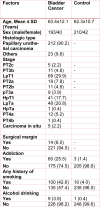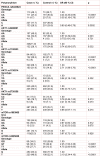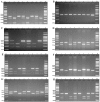Association between single nucleotide polymorphisms in the PI3K/AKT/mTOR pathway and bladder cancer risk in a sample of Iranian population
- PMID: 29383014
- PMCID: PMC5780628
- DOI: 10.17179/excli2017-329
Association between single nucleotide polymorphisms in the PI3K/AKT/mTOR pathway and bladder cancer risk in a sample of Iranian population
Abstract
In the past few years several investigations have focused on the role of PI3K/AKT/mTOR pathway and its deregulations in different cancers. This study aimed to examine genetic polymorphisms of this pathway in bladder cancer (BC). In this case-control study, 235 patients with pathologically confirmed bladder cancer and 254 control subjects were examined. PIK3CA, AKT1 and mTOR variants were analyzed using polymerase chain reaction-restriction fragment length polymorphism (PCR-RFLP). The findings proposed that the PIK3CA rs6443624 SNP significantly decreased the risk of BC (OR=0.44, 95 % CI=0.30-0.65, p<0.0001 CA vs CC; OR=0.35, 95 % CI=0.16-0.78, p=0.0107, AA vs CC; OR=0.60, 95 % CI=0.46-0.79, p=0.0002, A vs T). The AKT1 rs2498801 variant is associated with a decreased risk of BC (OR=0.57, 95 % CI=0.39-0.82, p=0.003, AG vs AA; OR=0.74, 95 % CI=0.56-0.97, p=0.032, G vs A) while, AKT1 rs1130233 polymorphism considerably increased the risk of BC (OR=3.70, 95 % CI=2.52-5.43, p<0.0001, GA vs GG; OR=5.81, 95 % CI=1.53-21.97, p=0.010, AA vs GG; OR=2.71, 95 % CI=1.98-3.70, p<0.0001, A vs G). Additionally, mTOR rs2295080 variant notably increased the risk of BC (OR=2.25, 95 % CI=1.50-3.38, p<0.0001, GT vs GG; OR=4.75, 95 % CI=2.80-8.06, p<0.0001, TT vs GG; OR=3.10, 95 % CI=2.34-4.10, p<0.0001, T vs G). None of the other examined polymorphisms (AKT1 rs1130214, AKT1 rs3730358, mTOR rs1883965) revealed significant association with BC. In conclusion, our findings suggest that PIK3CA rs6443624, AKT1 rs2498801, AKT1 rs1130233, as well mTOR rs2295080 polymorphism may be related to bladder cancer development in a sample of Iranian population. Validation of our findings in larger sample sizes of different ethnicities would provide evidence on the role of variants of PI3K/AKT/mTOR pathway in developing BC.
Keywords: AKT1; PIK3CA; bladder cancer; mTOR; polymorphism.
Figures




Similar articles
-
Association of Genetic Variations in The PIK3-AKT-mTOR Pathway with Endometriosis Susceptibility: A Preliminary Case-Control Study.Int J Fertil Steril. 2025 Mar 11;19(2):164-171. doi: 10.22074/ijfs.2024.2015384.1567. Int J Fertil Steril. 2025. PMID: 40200774 Free PMC article.
-
Effects of the MTOR and AKT1 genes polymorphisms on papillary thyroid cancer development.IUBMB Life. 2020 Dec;72(12):2601-2610. doi: 10.1002/iub.2388. Epub 2020 Oct 26. IUBMB Life. 2020. PMID: 33107190
-
The genetic variants in the PTEN/PI3K/AKT pathway predict susceptibility and CE(A)F chemotherapy response to breast cancer and clinical outcomes.Oncotarget. 2017 Mar 21;8(12):20252-20265. doi: 10.18632/oncotarget.15690. Oncotarget. 2017. PMID: 28423632 Free PMC article.
-
Significant association of catechol-O-methyltransferase Val158Met polymorphism with bladder cancer instead of prostate and kidney cancer.Int J Biol Markers. 2016 May 28;31(2):e110-7. doi: 10.5301/jbm.5000204. Int J Biol Markers. 2016. PMID: 27055785 Review.
-
Association between X-ray repair cross-complementing group 1 gene polymorphisms and glioma risk: a systematic review and meta-analysis based on 22 case-control studies.Int J Clin Exp Med. 2015 Aug 15;8(8):11863-80. eCollection 2015. Int J Clin Exp Med. 2015. PMID: 26550099 Free PMC article. Review.
Cited by
-
Associations of Genetic Polymorphisms of mTOR rs2295080 T/G and rs1883965 G/A with Susceptibility of Urinary System Cancers.Dis Markers. 2022 Jan 17;2022:1720851. doi: 10.1155/2022/1720851. eCollection 2022. Dis Markers. 2022. PMID: 35082928 Free PMC article.
-
Genetic and molecular biology of bladder cancer among Iranian patients.Mol Genet Genomic Med. 2020 Jun;8(6):e1233. doi: 10.1002/mgg3.1233. Epub 2020 Apr 6. Mol Genet Genomic Med. 2020. PMID: 32253828 Free PMC article. Review.
-
Association of Genetic Variations in The PIK3-AKT-mTOR Pathway with Endometriosis Susceptibility: A Preliminary Case-Control Study.Int J Fertil Steril. 2025 Mar 11;19(2):164-171. doi: 10.22074/ijfs.2024.2015384.1567. Int J Fertil Steril. 2025. PMID: 40200774 Free PMC article.
-
Connecting the dots between different networks: miRNAs associated with bladder cancer risk and progression.J Exp Clin Cancer Res. 2019 Oct 29;38(1):433. doi: 10.1186/s13046-019-1406-6. J Exp Clin Cancer Res. 2019. PMID: 31665050 Free PMC article.
-
A Comprehensive Review on the Importance of MiRNA-206 in the Animal Model and Human Diseases.Curr Neuropharmacol. 2024;22(6):1064-1079. doi: 10.2174/1570159X21666230407124146. Curr Neuropharmacol. 2024. PMID: 37032500 Free PMC article. Review.
References
-
- Aben KK, Witjes JA, Schoenberg MP, Hulsbergen-van de Kaa C, Verbeek AL, Kiemeney LA. Familial aggregation of urothelial cell carcinoma. Int J Cancer. 2002;98:274–278. - PubMed
-
- Agell L, Hernandez S, Salido M, de Muga S, Juanpere N, Arumi-Uria M, et al. PI3K signaling pathway is activated by PIK3CA mRNA overexpression and copy gain in prostate tumors, but PIK3CA, BRAF, KRAS and AKT1 mutations are infrequent events. Mod Pathol. 2011;24:443–452. - PubMed
-
- Bartholomeusz C, Gonzalez-Angulo AM. Targeting the PI3K signaling pathway in cancer therapy. Expert Opin Ther Targets. 2012;16:121–130. - PubMed
-
- Bellacosa A, Kumar CC, Di Cristofano A, Testa JR. Activation of AKT kinases in cancer: implications for therapeutic targeting. Adv Cancer Res. 2005;94:29–86. - PubMed
-
- Burger M, Catto JW, Dalbagni G, Grossman HB, Herr H, Karakiewicz P, et al. Epidemiology and risk factors of urothelial bladder cancer. Eur Urol. 2013;63:234–241. - PubMed
LinkOut - more resources
Full Text Sources
Miscellaneous
